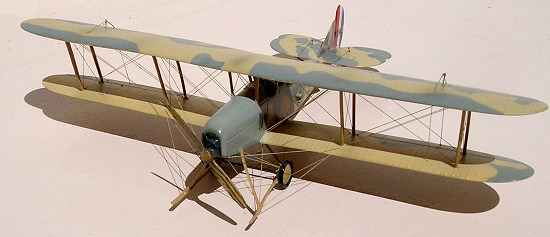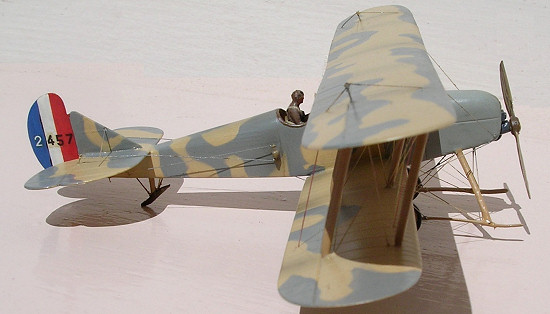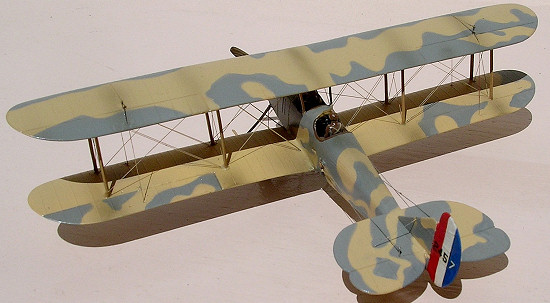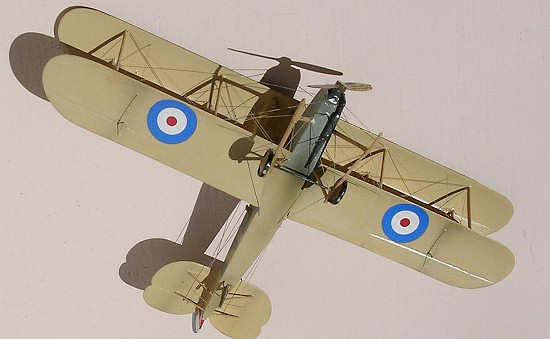
| KIT #: | ? |
| PRICE: | ? |
| DECALS: | None |
| REVIEWER: | Carmel J. Attard |
| NOTES: | Vacuform with resin parts |

| HISTORY |
Being an aircraft spotter myself apart from a scale modeller I am more familiar with aircraft of No7 Squadron RAF such as the Valiant bomber, or the Canberra TT18 when on various occasions in the past I spotted these aircraft staging into Luqa Airfield, stopping on their way to Akrotiri or some other place in the Far East. On a different note I got the kit of the RE5 not long ago and to my surprise I discovered that among the more attractive colour schemes suggested in the kit there was one that belonged to No7 Squadron and this made me realise that the history of the Squadron goes so many years back. The RE5 released by Roseplanes to a scale of 1/72 gives the chance for another early RFC aircraft that took part in the First World War.
 The RE5 was designed in 1913, first
flown in 1914 and was to be the Royal Flying Corps first real production
aircraft. The RE5 (RE stands for reconnaissance experimental) was a large two
seat tracker aircraft powered by a Bearmore 120HPAstro-Daimler in line engine
that was enclosed in a bull nose cowling. As with most early aircraft the
observer occupied the forward cockpit with the pilot seated at the rear. Twenty
four RE5s being built with the money received by the war office from the
Admiralty. 25,000 pounds was allocated to the RFC for the purchase of all the
aircraft. In spite that a small number of aircraft being manufactured, the RE5
played an important role in the RFC early operations in France. These served
with No2 Squadron RFC from September 1914 and No7 Squadron from April 1015. The
aircraft was used in some of the early bombing operations of the war. One
aircraft was used in a raid that acquired its pilot the Victoria Cross.
The RE5 was designed in 1913, first
flown in 1914 and was to be the Royal Flying Corps first real production
aircraft. The RE5 (RE stands for reconnaissance experimental) was a large two
seat tracker aircraft powered by a Bearmore 120HPAstro-Daimler in line engine
that was enclosed in a bull nose cowling. As with most early aircraft the
observer occupied the forward cockpit with the pilot seated at the rear. Twenty
four RE5s being built with the money received by the war office from the
Admiralty. 25,000 pounds was allocated to the RFC for the purchase of all the
aircraft. In spite that a small number of aircraft being manufactured, the RE5
played an important role in the RFC early operations in France. These served
with No2 Squadron RFC from September 1914 and No7 Squadron from April 1015. The
aircraft was used in some of the early bombing operations of the war. One
aircraft was used in a raid that acquired its pilot the Victoria Cross.
During the closing months of 1914
the Squadron No7 did not have an operational role as it was busy training its
own and other personnel and towards the end of 1914 at Joyce Gear it was
equipped with Gun Buses of “C” Flight. It was also during this period that the
Squadron also re-equipped with the RE5 aircraft, the first of which arrived on
the 20th of October. By that time it was ready for embarkation the
squadron consisted of 2 Flights of RE5 and one of Vickers. On the 28th
March of 1915 the War Office notified HQ in the field that No7Sq would embark
for France on 3rd and 4th April. The move did not go
without problems as two Vickers Gunbus went unserviceable and one RE5 caught
fire at Falkstone prior to crossing the channel and one Vickers crashed on
landing at Bourthes. The remaining seven RE5s and one Vickers landed safely. It
only took a week of familiarisation and the
 Squadron was declared ready
for operations. During those early sorties over Belgium 20 pound bombs were
dropped by hand over the side of the cockpit. Eventually the task of the
Squadron was for the rest of the war was to become tactical reconnaissance,
artillery observation and light bombing and at times provided fighter cover.
Squadron was declared ready
for operations. During those early sorties over Belgium 20 pound bombs were
dropped by hand over the side of the cockpit. Eventually the task of the
Squadron was for the rest of the war was to become tactical reconnaissance,
artillery observation and light bombing and at times provided fighter cover.
It was on the 31st of July 1915 that an RE5 of No7 Sq. staggered back to St.Omer badly damaged. Its control wheel and throttle were smashed, one of the undercarriage struts badly damaged and the pilot Capt.J.A.Liddell had a broken right thigh. Despite all difficulties the pilot managed to make a good landing, so saving the life of the observer Lt.R.M.Beck. The aircraft was hit when it came under heavy fire during low flying on recce patrol over Ostend, Bruges and Ghent. The severity of the wound suffered by Captain Liddell caused momentary unconscious and by a great effort was able to recover partial control of his aircraft after it had dived 3,000 Ft .He continued his recce for another 30 minutes, continually under fire before returning to Allied lines and making a safe landing. Few of those who lifted John Liddell from his smashed aircraft realised that within 3 weeks his award of the Victoria Cross would be announced in the London Gazette. Liddell who received his aviator’s certificate No 781 on the 14th of May 1914 on Vickers at Brooklands was to succumb to his injuries 4 weeks after his aircraft was damaged, despite immediate attention and the best medical care available in the field hospital. Liddell died of septic poisoning on the 31st of August of 1915. Capt. Liddell awarded the RFC’s second VC and the only one ever awarded to the Squadron. He only joined the squadron on the 23rd of July and was on one of his first operations. His name stands at the Head of a long list that records the many awards of valour awarded to men who served with No7 Sq. The Squadron was equipped with eight RE5s between Oct.1914 and Sept.1915.
 One RE5 bomber was used by the RNAS
operating from Dunkirk during September 1914. Its serial number was 26. The
reliability and straight forward handling qualities that were inherited from its
predecessor designs was offsetted by lack of agility and absence of protective
armament. This detracted seriously its operational value and hence its short
lived career. It was removed from front line service by autumn 1915 to make way
for newer designs. The sixth production RE5 was converted to a single seater
with extended wing span for higher altitudes flying trials. This has in fact
reached a height of 17,000 feet in June 1914. Another similarly modified machine
was employed for flight trials of the factory 336 pound wt. bomb which came to
be the prelude to the subsequent RE7. The RE5s that served with RFC were
361,380,382,617,631,651,674,677,678,688,737,745,2456,2457,2458,2459 and 2461. Of
a total of 24 RE5s, 22 were produced in 1914 and two in 1915. 11 of the RE5s
were known to be allocated to France, and 9 aircraft to training units.
One RE5 bomber was used by the RNAS
operating from Dunkirk during September 1914. Its serial number was 26. The
reliability and straight forward handling qualities that were inherited from its
predecessor designs was offsetted by lack of agility and absence of protective
armament. This detracted seriously its operational value and hence its short
lived career. It was removed from front line service by autumn 1915 to make way
for newer designs. The sixth production RE5 was converted to a single seater
with extended wing span for higher altitudes flying trials. This has in fact
reached a height of 17,000 feet in June 1914. Another similarly modified machine
was employed for flight trials of the factory 336 pound wt. bomb which came to
be the prelude to the subsequent RE7. The RE5s that served with RFC were
361,380,382,617,631,651,674,677,678,688,737,745,2456,2457,2458,2459 and 2461. Of
a total of 24 RE5s, 22 were produced in 1914 and two in 1915. 11 of the RE5s
were known to be allocated to France, and 9 aircraft to training units.
| THE KIT |
Roseplane of Rosemont Hobby Shop of 4317 Howerton Road, Northampton, A 18067. USA, (610) 502-1137 released the RE5 kit to a scale of 1/72 circa 1999. The kit comes as a neat vacform kit along with the intricate parts made in resin.
| CONSTRUCTION |
Though it is a vacform kit it is a simple one to construct
as long as there is no rush in going about building the model. Care is taken not
to spoil the fine surface detail. The tricky part is in correctly aligning the
wings and undercarriage skids and struts. The kit comes complete w ith
instructions on steps to follow during building the model and is worth spending
time in going through even if you are a practising vacform kit modeller. There
is ample of information to help you select the RE5 that you desire to build
whether it is a short span or a long span type. I opted for the short span one
since the instruction contained convincing camouflage pattern and detail.
ith
instructions on steps to follow during building the model and is worth spending
time in going through even if you are a practising vacform kit modeller. There
is ample of information to help you select the RE5 that you desire to build
whether it is a short span or a long span type. I opted for the short span one
since the instruction contained convincing camouflage pattern and detail.
| COLORS & MARKINGS |
This consisted of semi matt silk 314 RAL 1001 with irregular FS 36231 grey (very close to medium grey) areas. The aircraft depicted in this scheme was Capt. Liddell’s RE5. The aircraft tail number was 2457. These were in blue with no outline except for the numbers that falls on the blue rudder stripe which were white and no outline. No2 on the stb.side and No7 on the port side. The instruction sheet states that the exact camouflage pattern was difficult to discern it was with help from the publication of Flying Press by Alan Durkota and Windsock Data file by Ray Rimell that it got closer to what this should be. The kit comes with no decals and one has to fork out from spares box as I had to do or find close decals for which information as to size of roundels required is also given in the various reference materials in form of sketches that comes with the kit.
| CONCLUSIONS |
Upon completion, the kit was placed alongside the model of the RE7.This provided a contrast in size and general aircraft design in the evolution of the RE reconnaissance bombers which led to the famous RE8.
| REFERENCES |
Nothing heard after take off. History of No 7 RAF Squadron.
The history of British Aviation 1908-1914 Vol 2 by R.Dallas Brett.
February 2006
Copyright ModelingMadness.com. All rights reserved. No reproduction in part or in whole without express permission from the editor.
If you would like your product reviewed fairly and fairly quickly, please contact the editor or see other details in the Note to Contributors.